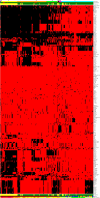Genotypic and phenotypic traits that distinguish neonatal meningitis-associated Escherichia coli from fecal E. coli isolates of healthy human hosts
- PMID: 22706051
- PMCID: PMC3406136
- DOI: 10.1128/AEM.07869-11
Genotypic and phenotypic traits that distinguish neonatal meningitis-associated Escherichia coli from fecal E. coli isolates of healthy human hosts
Abstract
Neonatal meningitis Escherichia coli (NMEC) is one of the top causes of neonatal meningitis worldwide. Here, 85 NMEC and 204 fecal E. coli isolates from healthy humans (HFEC) were compared for possession of traits related to virulence, antimicrobial resistance, and plasmid content. This comparison was done to identify traits that typify NMEC and distinguish it from commensal strains to refine the definition of the NMEC subpathotype, identify traits that might contribute to NMEC pathogenesis, and facilitate choices of NMEC strains for future study. A large number of E. coli strains from both groups were untypeable, with the most common serogroups occurring among NMEC being O18, followed by O83, O7, O12, and O1. NMEC strains were more likely than HFEC strains to be assigned to the B2 phylogenetic group. Few NMEC or HFEC strains were resistant to antimicrobials. Genes that best discriminated between NMEC and HFEC strains and that were present in more than 50% of NMEC isolates were mainly from extraintestinal pathogenic E. coli genomic and plasmid pathogenicity islands. Several of these defining traits had not previously been associated with NMEC pathogenesis, are of unknown function, and are plasmid located. Several genes that had been previously associated with NMEC virulence did not dominate among the NMEC isolates. These data suggest that there is much about NMEC virulence that is unknown and that there are pitfalls to studying single NMEC isolates to represent the entire subpathotype.
Figures

References
-
- Anonymous 2009. National Antimicrobial Resistance Monitoring System—Enteric Bacteria (NARMS) 2009 annual report. Centers for Disease Control and Prevention, Atlanta, GA
-
- Anonymous 2010. SAS/STAT(R) 9.22 user's guide. SAS Institute Inc., Cary, NC
-
- Croxen MA, Finlay BB. 2010. Molecular mechanisms of Escherichia coli pathogenicity. Nat. Rev. Microbiol. 8:26–38 - PubMed
Publication types
MeSH terms
Substances
LinkOut - more resources
Full Text Sources
Medical

